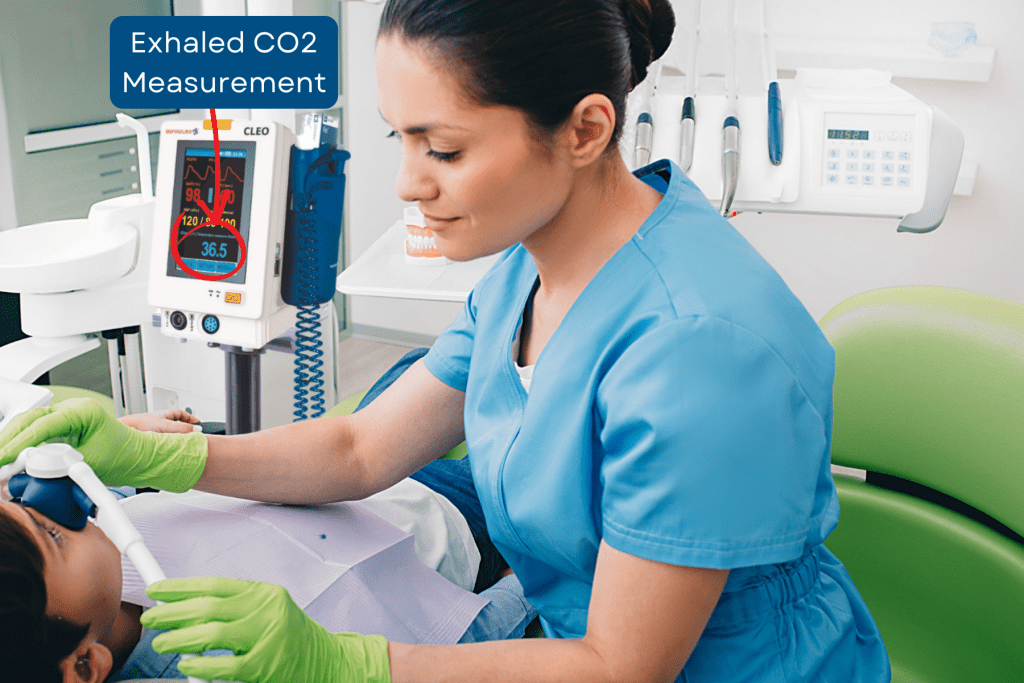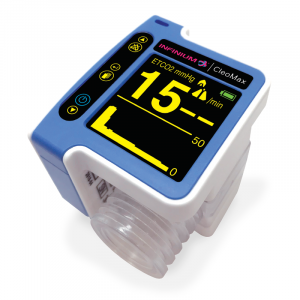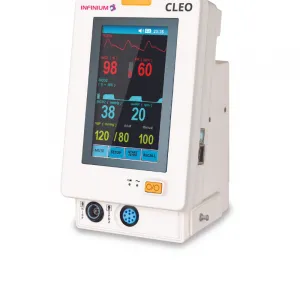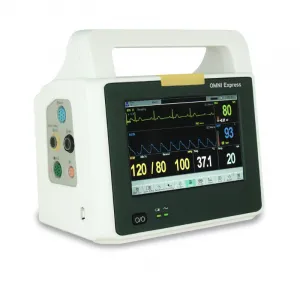Purpose & Definition
A capnograph is a medical device that rapidly measures respiratory health to assist health care providers to respond sooner when patients are not breathing normally. It measures the amount of carbon dioxide ( CO2 ) in exhaled air and provides real-time data and graphical waveform readings. It is used in capnography and is also known as an EtCO2 monitor. Earlier versions were considered a capnometer. The difference between a capnometer and a capnograph is that the capnograph provides the measurement data in a timeline graph known as the capnography waveform. This waveform gives experienced practitioners detailed insights into the patient’s condition and the effectiveness of their breathing over specific timelines.

Capnograph Monitoring Device FAQs
What is Capnography?
Oxygen enters your body’s bloodstream via the lungs and then travels throughout the body to aid in metabolism. Your body’s metabolism breaks down the food you eat in order to produce energy, and as a byproduct of this process, your body excretes a gaseous waste product called carbon dioxide (Co2) into your blood. This then travels back to your lungs and exits your body through an exhaled breath. Capnography refers to the use of a capnograph to measure the levels of exhaled carbon dioxide, or CO2, in the bloodstream. This is commonly known as End-Tidal CO2 or EtCO2 measurement. This is an ideal predictor of what a patient’s blood oxygen levels will be in the coming moments and allows practitioners to intervene faster.
How does a Capnograph make Measurements?
A capnograph monitor measures exhaled breath by plotting the partial pressure of CO2 in wavelength form on an x and y-axis grid. The capnograph displays wavelengths as well as numbered measurements – a normal reading falls between 30 and 40. If a patient’s number falls below 30 it is a strong indication that the patient isn’t receiving enough oxygen due to a problem with the endotracheal tube or a general medical complication. The capnograph is the patient’s direct line of communication to his or her doctor when they are unable to speak for themselves.
There are two main methods for collecting and measuring the exhaled gas:
- Mainstream: A sample cell airway adapter is inserted directly in the airway between the breathing circuit and the endotracheal tube.
- Sidestream: The EtCO2 sensor is located in the main unit away from the airway and a small pump sends gas samples from the patient through a sampling tube into the main unit. The sampling tube is connected to a T-connector at the endotracheal tube, anesthesia mask connector, or directly from the nasal cavity using a breathing cannula and nasal adapters.
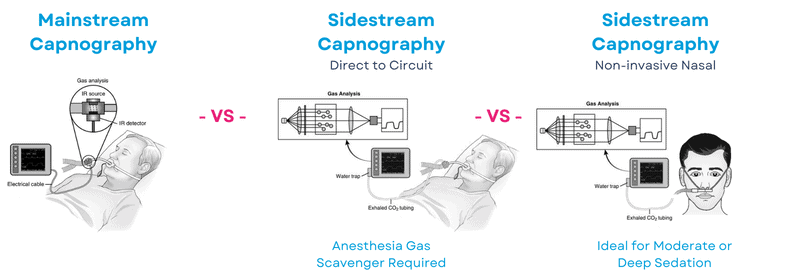
There are two main types of monitors, one is a portable dedicated EtCO2 capnograph with that as its primary function. The other is with EtCO2 modules within a multiparameter monitor setup and part of a broader set of measurements. Bedside, Operating Room, and EMS Defibrillators often have this parameter built in.
When are Capnographs Used?
Capnographs measure the extent to which a person is breathing normally and gas is being exchanged in the lungs properly. This leads to many practical uses in the field of medicine. The four most common scenarios are:
- During emergency response scenarios where the person may not be breathing or is in cardiac arrest.
- In continuous monitoring situations where the patient is critically ill and breathing can deteriorate rapidly.
- Any time a person is being sedated or under moderate to heavy sedation. Typically for minor or major surgical procedures.
- During lung function testing on patients with chronic conditions like sleep apnea and COP
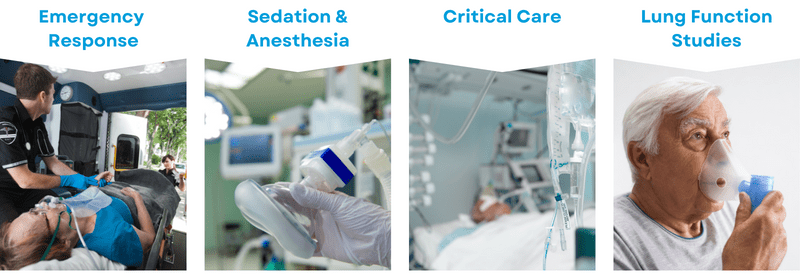
Is Capnography a Standard, is it Required?
Capnography is now considered the best standard of care for the above scenarios. All major associations and standards boards have written it into their requirements or recommendations. You will find it as part of the standards from the Association of Air Medical Services, American Academy of Pediatrics, American Academy of Pediatric Dentistry, American Association for Respiratory Care, American Academy of Sleep Medicine, American College of Emergency Physicians, American Heart Association, Anesthesia Patient Safety Foundation, American Society of Anesthesiologists, American Association for the Study of Liver Diseases, American College of Gastroenterology, American Gastroenterological Association, American Society for Gastrointestinal Endoscopy, Emergency Nurses Association, Institute for Safe Medication Practices, Joint Commission, National Association of State Emergency Medical Services Directors, National Association of State EMS Officials, The Society of Critical Care Medicine.
It is also a standard with countless regional and state organizations. This is not legal advice, but yes, it is considered a required standard of care in most cases.
Why can Measuring EtCO2 be Better than Measuring SpO2?
It is a much faster and better predictor of root causes. EtCO2 can assess real-time respiratory function. Carbon dioxide is 20 times more soluble than oxygen. If a patient is not breathing normally CO2 levels change quickly and blood O2 gradually degrades. SpO2 measures blood oxygen saturation. Once the respiratory system has been compromised blood level O2 will subsequently decline to critical levels. Measuring exhaled CO2 predicts what will happen next with O2 in the blood. This saves critical seconds and sometimes minutes. See more on capnography monitoring >
EtCO2 Monitoring:
- Real-time breathing gas exchange and ventilation assessment
- Immediately changes when the patient is not breathing normally
- Not affected by supplemental oxygen
- Great for accurate spot checks
- Can be measured via invasive or non-invasive methods
SpO2 Monitoring:
- Very non-invasive with simple finger sensors
- Measures blood oxygenation and detects hypoxia
- Better for continuous non-critical bedside condition
How Much Do They Typically Cost?
Capnography and EtCO2 monitors can be found from a wide variety of manufacturers and the costs can vary considerably. As of 2022, dedicated portable units are typically in the $1,200 to $4,800 range. EtCO2 built into multi-parameter monitors can range from $4,000 to $12,000. Higher-end specialty monitors and EtCO2 built into defibrillators/monitors can be upwards of $35,000.
What are some Reputable Brands?
As with any medical device purchase, you should stick with brands you can trust, that have been in the space for a number of years, and that can provide the needed support services. Some of the main reputable brands you will find in the capnography space are GE, Philips, Medtronic, Infinium, Drager, Nonin, and Spacelabs. The Infinium Cleo Portable Capnograph is a good choice in terms of a high-quality portable unit and is still very budget-friendly.
What Type of Accessories and Supplies Are Needed?
For sidestream monitoring, the primary disposable supply is co2 nasal sampling lines, these can run from $2.50 to $10 per patient. The primary disposable with mainstream technology is airway adapters. Other items to consider are t-connectors, extension cables, filter lines, water/moisture traps. These may be needed depending on maintenance and your individual setup.

